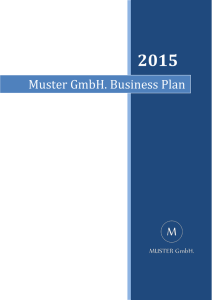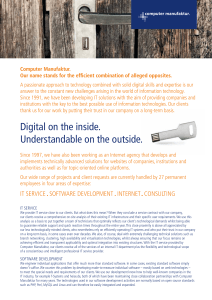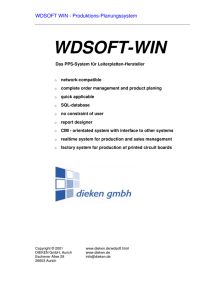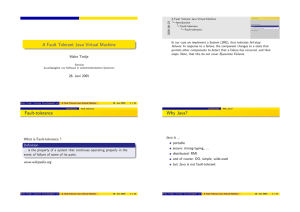Ethical Hacking CEHv7 Course Outline
Werbung
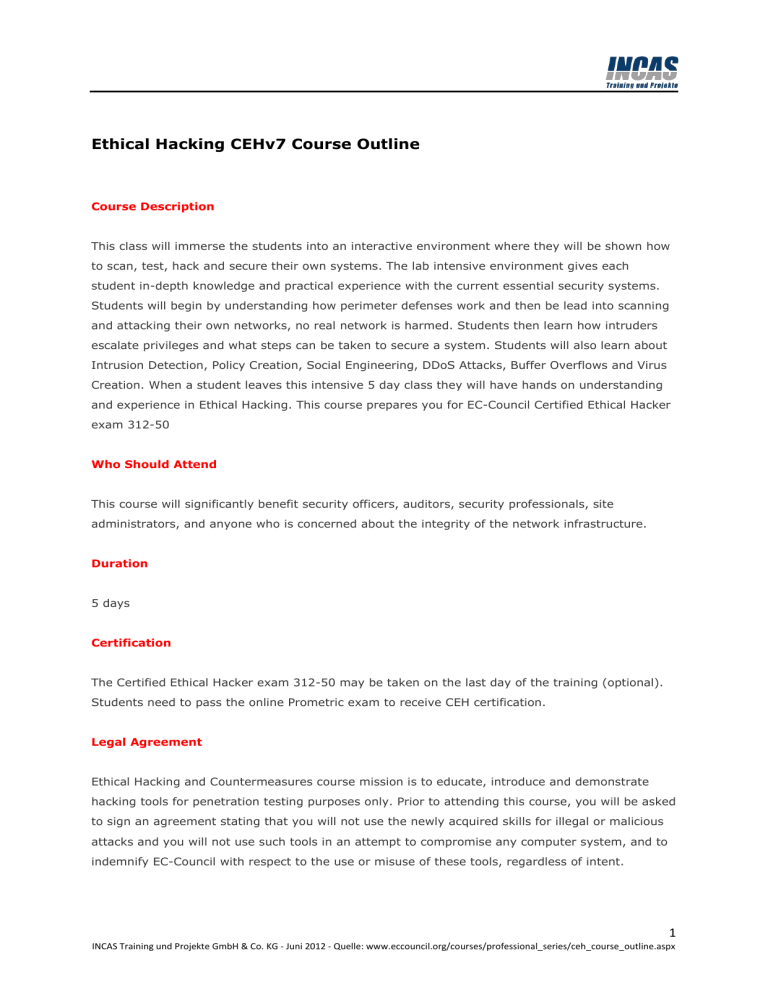
Ethical Hacking CEHv7 Course Outline Course Description This class will immerse the students into an interactive environment where they will be shown how to scan, test, hack and secure their own systems. The lab intensive environment gives each student in-depth knowledge and practical experience with the current essential security systems. Students will begin by understanding how perimeter defenses work and then be lead into scanning and attacking their own networks, no real network is harmed. Students then learn how intruders escalate privileges and what steps can be taken to secure a system. Students will also learn about Intrusion Detection, Policy Creation, Social Engineering, DDoS Attacks, Buffer Overflows and Virus Creation. When a student leaves this intensive 5 day class they will have hands on understanding and experience in Ethical Hacking. This course prepares you for EC-Council Certified Ethical Hacker exam 312-50 Who Should Attend This course will significantly benefit security officers, auditors, security professionals, site administrators, and anyone who is concerned about the integrity of the network infrastructure. Duration 5 days Certification The Certified Ethical Hacker exam 312-50 may be taken on the last day of the training (optional). Students need to pass the online Prometric exam to receive CEH certification. Legal Agreement Ethical Hacking and Countermeasures course mission is to educate, introduce and demonstrate hacking tools for penetration testing purposes only. Prior to attending this course, you will be asked to sign an agreement stating that you will not use the newly acquired skills for illegal or malicious attacks and you will not use such tools in an attempt to compromise any computer system, and to indemnify EC-Council with respect to the use or misuse of these tools, regardless of intent. 1 INCAS Training und Projekte GmbH & Co. KG - Juni 2012 - Quelle: www.eccouncil.org/courses/professional_series/ceh_course_outline.aspx Not anyone can be a student — the Accredited Training Centers (ATC) will make sure the applicants work for legitimate companies. Course Outline Version 7 CEHv7 Curriculum consists of instructor-led training and self-study. The Instructor will provide the details of self-study modules to the students beginning of the class. Module 01: Introduction to Ethical Hacking Internet Crime Current Report: IC3 Data Breach Investigations Report Types of Data Stolen From the Organizations Essential Terminologies Elements of Information Security Authenticity and Non-Repudiation The Security, Functionality, and Usability Triangle Security Challenges Effects of Hacking Effects of Hacking on Business Who is a Hacker? Hacker Classes Hacktivism What Does a Hacker Do? Phase 1 - Reconnaissance Reconnaissance Types Phase 2 - Scanning Phase 3 – Gaining Access Phase 4 – Maintaining Access Phase 5 – Covering Tracks Types of Attacks on a System Operating System Attacks Application-Level Attacks Shrink Wrap Code Attacks Misconfiguration Attacks Why Ethical Hacking is Necessary? Defense in Depth 2 INCAS Training und Projekte GmbH & Co. KG - Juni 2012 - Quelle: www.eccouncil.org/courses/professional_series/ceh_course_outline.aspx Scope and Limitations of Ethical Hacking What Do Ethical Hackers Do? Skills of an Ethical Hacker Vulnerability Research Vulnerability Research Websites What is Penetration Testing? Why Penetration Testing? Penetration Testing Methodology Module 02: Footprinting and Reconnaissance Footprinting Terminologies What is Footprinting? Objectives of Footprinting Footprinting Threats Finding a Company’s URL Locate Internal URLs Public and Restricted Websites Search for Company’s Information Tools to Extract Company’s Data Footprinting Through Search Engines Collect Location Information Satellite Picture of a Residence People Search People Search Using http://pipl.com People Search Online Services People Search on Social Networking Services Gather Information from Financial Services Footprinting Through Job Sites Monitoring Target Using Alerts Competitive Intelligence Gathering Competitive Intelligence-When Did this Company Begin? How Did it Develop? Competitive Intelligence-What are the Company's Plans? Competitive Intelligence-What Expert Opinion Say About the Company? Competitive Intelligence Tools Competitive Intelligence Consulting Companies WHOIS Lookup 3 INCAS Training und Projekte GmbH & Co. KG - Juni 2012 - Quelle: www.eccouncil.org/courses/professional_series/ceh_course_outline.aspx WHOIS Lookup Result Analysis WHOIS Lookup Tools: SmartWhois WHOIS Lookup Tools WHOIS Lookup Online Tools Extracting DNS Information DNS Interrogation Tools DNS Interrogation Online Tools Locate the Network Range Traceroute Traceroute Analysis Traceroute Tool: 3D Traceroute Traceroute Tool: LoriotPro Traceroute Tool: Path Analyzer Pro Traceroute Tools Mirroring Entire Website Website Mirroring Tools Mirroring Entire Website Tools Extract Website Information from http://www.archive.org Monitoring Web Updates Using Website Watcher Tracking Email Communications Email Tracking Tools Footprint Using Google Hacking Techniques What a Hacker Can Do With Google Hacking? Google Advance Search Operators Finding Resources using Google Advance Operator Google Hacking Tool: Google Hacking Database (GHDB) Google Hacking Tools Additional Footprinting Tools Footprinting Countermeasures Footprinting Pen Testing Module 03: Scanning Networks Network Scanning Types of Scanning Checking for Live Systems - ICMP Scanning Ping Sweep 4 INCAS Training und Projekte GmbH & Co. KG - Juni 2012 - Quelle: www.eccouncil.org/courses/professional_series/ceh_course_outline.aspx Ping Sweep Tools Three-Way Handshake TCP Communication Flags Create Custom Packet using TCP Flags Hping2 / Hping3 Hping Commands Scanning Techniques TCP Connect / Full Open Scan Stealth Scan (Half-open Scan) Xmas Scan FIN Scan NULL Scan IDLE Scan IDLE Scan: Step 1 IDLE Scan: Step 2.1 (Open Port) IDLE Scan: Step 2.2 (Closed Port) IDLE Scan: Step 3 ICMP Echo Scanning/List Scan SYN/FIN Scanning Using IP Fragments UDP Scanning Inverse TCP Flag Scanning ACK Flag Scanning Scanning: IDS Evasion Techniques IP Fragmentation Tools Scanning Tool: Nmap Scanning Tool: NetScan Tools Pro Scanning Tools Do Not Scan These IP Addresses (Unless you want to get into trouble) Scanning Countermeasures War Dialing Why War Dialing? War Dialing Tools War Dialing Countermeasures War Dialing Countermeasures: SandTrap Tool OS Fingerprinting 5 INCAS Training und Projekte GmbH & Co. KG - Juni 2012 - Quelle: www.eccouncil.org/courses/professional_series/ceh_course_outline.aspx Active Banner Grabbing Using Telnet Banner Grabbing Tool: ID Serve GET REQUESTS Banner Grabbing Tool: Netcraft Banner Grabbing Tools Banner Grabbing Countermeasures: Disabling or Changing Banner Hiding File Extensions Hiding File Extensions from Webpages Vulnerability Scanning Vulnerability Scanning Tool: Nessus Vulnerability Scanning Tool: SAINT Vulnerability Scanning Tool: GFI LANGuard Network Vulnerability Scanners LANsurveyor Network Mappers Proxy Servers Why Attackers Use Proxy Servers? Use of Proxies for Attack How Does MultiProxy Work? Free Proxy Servers Proxy Workbench Proxifier Tool: Create Chain of Proxy Servers SocksChain TOR (The Onion Routing) TOR Proxy Chaining Software HTTP Tunneling Techniques Why do I Need HTTP Tunneling? Super Network Tunnel Tool Httptunnel for Windows Additional HTTP Tunneling Tools SSH Tunneling SSL Proxy Tool How to Run SSL Proxy? Proxy Tools Anonymizers 6 INCAS Training und Projekte GmbH & Co. KG - Juni 2012 - Quelle: www.eccouncil.org/courses/professional_series/ceh_course_outline.aspx Types of Anonymizers Case: Bloggers Write Text Backwards to Bypass Web Filters in China Text Conversion to Avoid Filters Censorship Circumvention Tool: Psiphon How Psiphon Works? How to Check if Your Website is Blocked in China or Not? G-Zapper Anonymizer Tools Spoofing IP Address IP Spoofing Detection Techniques: Direct TTL Probes IP Spoofing Detection Techniques: IP Identification Number IP Spoofing Detection Techniques: TCP Flow Control Method IP Spoofing Countermeasures Scanning Pen Testing Module 04: Enumeration What is Enumeration? Techniques for Enumeration Netbios Enumeration NetBIOS Enumeration Tool: SuperScan NetBIOS Enumeration Tool: NetBIOS Enumerator Enumerating User Accounts Enumerate Systems Using Default Passwords SNMP (Simple Network Management Protocol) Enumeration Management Information Base (MIB) SNMP Enumeration Tool: OpUtils Network Monitoring Toolset SNMP Enumeration Tool: SolarWinds SNMP Enumeration Tools UNIX/Linux Enumeration Linux Enumeration Tool: Enum4linux LDAP Enumeration LDAP Enumeration Tool: JXplorer LDAP Enumeration Tool NTP Enumeration NTP Server Discovery Tool: NTP Server Scanner NTP Server: PresenTense Time Server 7 INCAS Training und Projekte GmbH & Co. KG - Juni 2012 - Quelle: www.eccouncil.org/courses/professional_series/ceh_course_outline.aspx SMTP Enumeration DNS Analyzing and Enumeration Tool: The Men & Mice Suite Enumeration Countermeasures SMTP Enumeration Tool: NetScanTools Pro DNS Zone Transfer Enumeration Using nslookup NTP Enumeration Tools SMB Enumeration Countermeasures Enumeration Pen Testing Module 05: System Hacking Information at Hand Before System Hacking Stage System Hacking: Goals CEH Hacking Methodology (CHM) Password Cracking Password Complexity Password Cracking Techniques Types of Password Attacks Passive Online Attacks: Wire Sniffing Password Sniffing Passive Online Attack: Man-in-the-Middle and Replay Attack Active Online Attack: Password Guessing Active Online Attack: Trojan/Spyware/Keylogger Active Online Attack: Hash Injection Attack Rainbow Attacks: Pre-Computed Hash Distributed Network Attack Elcomsoft Distributed Password Recovery Non-Electronic Attacks Default Passwords Manual Password Cracking (Guessing) Automatic Password Cracking Algorithm Stealing Passwords Using USB Drive Microsoft Authentication How Hash Passwords are Stored in Windows SAM? What is LAN Manager Hash? LM “Hash” Generation LM, NTLMv1, and NTLMv2 8 INCAS Training und Projekte GmbH & Co. KG - Juni 2012 - Quelle: www.eccouncil.org/courses/professional_series/ceh_course_outline.aspx NTLM Authentication Process Kerberos Authentication Salting PWdump7 and Fgdump L0phtCrack Ophcrack Cain & Abel RainbowCrack Password Cracking Tools LM Hash Backward Compatibility How to Defend against Password Cracking? How to Disable LM HASH? Implement and Enforce Strong Security Policy Privilege Escalation Escalation of Privileges Active@ Password Changer Privilege Escalation Tools How to Defend against Privilege Escalation? Executing Applications Alchemy Remote Executor RemoteExec Execute This! Keylogger Types of Keystroke Loggers Acoustic/CAM Keylogger Keylogger: Advanced Keylogger Keylogger: Spytech SpyAgent Keylogger: Perfect Keylogger Keylogger: Powered Keylogger Keylogger for Mac: Aobo Mac OS X KeyLogger Keylogger for Mac: Perfect Keylogger for Mac Hardware Keylogger: KeyGhost Keyloggers Spyware What Does the Spyware Do? 9 INCAS Training und Projekte GmbH & Co. KG - Juni 2012 - Quelle: www.eccouncil.org/courses/professional_series/ceh_course_outline.aspx Types of Spywares Desktop Spyware Desktop Spyware: Activity Monitor Email and Internet Spyware Email and Internet Spyware: eBLASTER Internet and E-mail Spyware Child Monitoring Spyware Screen Capturing Spyware Screen Capturing Spyware: Spector Pro USB Spyware Child Monitoring Spyware: Advanced Parental Control USB Spyware: USBDumper Audio Spyware Audio Spyware: RoboNanny, Stealth Recorder Pro and Spy Voice Recorder Video Spyware Print Spyware Telephone/Cellphone Spyware Cellphone Spyware: Mobile Spy GPS Spyware GPS Spyware: GPS TrackMaker How to Defend against Keyloggers? Anti-Keylogger Anti-Keylogger: Zemana AntiLogger Anti-Keyloggers How to Defend against Spyware? Anti-Spyware: Spyware Doctor Rootkits Types of Rootkits How Rootkit Works? Rootkit: Fu Detecting Rootkits Print Spyware: Printer Activity Monitor Video Spyware: Net Video Spy Steps for Detecting Rootkits How to Defend against Rootkits? 10 INCAS Training und Projekte GmbH & Co. KG - Juni 2012 - Quelle: www.eccouncil.org/courses/professional_series/ceh_course_outline.aspx Anti-Rootkit: RootkitRevealer and McAfee Rootkit Detective NTFS Data Stream How to Create NTFS Streams? NTFS Stream Manipulation How to Defend against NTFS Streams? NTFS Stream Detector: ADS Scan Engine NTFS Stream Detectors What is Steganography? Steganography Techniques How Steganography Works? Types of Steganography Image Steganography Image Steganography: Hermetic Stego Image Steganography Tools Document Steganography: wbStego Video Steganography Tools Audio Steganography: Mp3stegz Document Steganography Tools Video Steganography: Our Secret Whitespace Steganography Tool: SNOW Audio Steganography Tools Folder Steganography: Invisible Secrets 4 Folder Steganography Tools Spam/Email Steganography: Spam Mimic Natural Text Steganography: Sams Big G Play Maker Steganalysis Steganography Detection Tool: Stegdetect Steganalysis Methods/Attacks on Steganography Steganography Detection Tools Why Cover Tracks? Covering Tracks Ways to Clear Online Tracks Disabling Auditing: Auditpol Covering Tracks Tool: Window Washer Covering Tracks Tool: Tracks Eraser Pro 11 INCAS Training und Projekte GmbH & Co. KG - Juni 2012 - Quelle: www.eccouncil.org/courses/professional_series/ceh_course_outline.aspx Track Covering Tools System Hacking Penetration Testing Module 06: Trojans and Backdoors What is a Trojan? Overt and Covert Channels Purpose of Trojans What Do Trojan Creators Look For? Indications of a Trojan Attack Common Ports used by Trojans How to Infect Systems Using a Trojan? Wrappers Wrapper Covert Programs Different Ways a Trojan can Get into a System How to Deploy a Trojan? Evading Anti-Virus Techniques Types of Trojans Command Shell Trojans Command Shell Trojan: Netcat GUI Trojan: MoSucker GUI Trojan: Jumper and Biodox Document Trojans E-mail Trojans Defacement Trojans Defacement Trojans: Restorator Botnet Trojans Botnet Trojan: Illusion Bot Botnet Trojan: NetBot Attacker Proxy Server Trojans E-mail Trojans: RemoteByMail Proxy Server Trojan: W3bPrOxy Tr0j4nCr34t0r (Funny Name) FTP Trojans FTP Trojan: TinyFTPD VNC Trojans HTTP/HTTPS Trojans HTTP Trojan: HTTP RAT 12 INCAS Training und Projekte GmbH & Co. KG - Juni 2012 - Quelle: www.eccouncil.org/courses/professional_series/ceh_course_outline.aspx Shttpd Trojan - HTTPS (SSL) ICMP Tunneling ICMP Trojan: icmpsend Remote Access Trojans Remote Access Trojan: RAT DarkComet Remote Access Trojan: Apocalypse Covert Channel Trojan: CCTT E-banking Trojans Banking Trojan Analysis E-banking Trojan: ZeuS Destructive Trojans Notification Trojans Credit Card Trojans Data Hiding Trojans (Encrypted Trojans) BlackBerry Trojan: PhoneSnoop MAC OS X Trojan: DNSChanger MAC OS X Trojan: DNSChanger Mac OS X Trojan: Hell Raiser How to Detect Trojans? Scanning for Suspicious Ports Port Monitoring Tool: IceSword Port Monitoring Tools: CurrPorts and TCPView Scanning for Suspicious Processes Process Monitoring Tool: What's Running Process Monitoring Tools Scanning for Suspicious Registry Entries Registry Entry Monitoring Tools Scanning for Suspicious Device Drivers Device Drivers Monitoring Tools: DriverView Device Drivers Monitoring Tools Scanning for Suspicious Windows Services Windows Services Monitoring Tools: Windows Service Manager (SrvMan) Windows Services Monitoring Tools Scanning for Suspicious Startup Programs Windows7 Startup Registry Entries 13 INCAS Training und Projekte GmbH & Co. KG - Juni 2012 - Quelle: www.eccouncil.org/courses/professional_series/ceh_course_outline.aspx Startup Programs Monitoring Tools: Starter Startup Programs Monitoring Tools: Security AutoRun Startup Programs Monitoring Tools Scanning for Suspicious Files and Folders Files and Folder Integrity Checker: FastSum and WinMD5 Files and Folder Integrity Checker Scanning for Suspicious Network Activities Detecting Trojans and Worms with Capsa Network Analyzer Trojan Countermeasures Backdoor Countermeasures Trojan Horse Construction Kit Anti-Trojan Software: TrojanHunter Anti-Trojan Software: Emsisoft Anti-Malware Anti-Trojan Softwares Pen Testing for Trojans and Backdoors Module 07: Viruses and Worms Introduction to Viruses Virus and Worm Statistics 2010 Stages of Virus Life Working of Viruses: Infection Phase Working of Viruses: Attack Phase Why Do People Create Computer Viruses? Indications of Virus Attack How does a Computer get Infected by Viruses? Virus Hoaxes Virus Analysis: W32/Sality AA W32/Toal-A W32/Virut Klez Types of Viruses System or Boot Sector Viruses File and Multipartite Viruses Macro Viruses Cluster Viruses 14 INCAS Training und Projekte GmbH & Co. KG - Juni 2012 - Quelle: www.eccouncil.org/courses/professional_series/ceh_course_outline.aspx Stealth/Tunneling Viruses Encryption Viruses Polymorphic Code Metamorphic Viruses File Overwriting or Cavity Viruses Sparse Infector Viruses Companion/Camouflage Viruses Shell Viruses File Extension Viruses Add-on and Intrusive Viruses Transient and Terminate and Stay Resident Viruses Writing a Simple Virus Program Terabit Virus Maker JPS Virus Maker DELmE's Batch Virus Maker Computer Worms How is a Worm Different from a Virus? Example of Worm Infection: Conficker Worm What does the Conficker Worm do? How does the Conficker Worm Work? Worm Analysis: W32/Netsky W32/Bagle.GE Worm Maker: Internet Worm Maker Thing What is Sheep Dip Computer? Anti-Virus Sensors Systems Malware Analysis Procedure String Extracting Tool: Bintext Compression and Decompression Tool: UPX Process Monitoring Tools: Process Monitor Log Packet Content Monitoring Tools: NetResident Debugging Tool: Ollydbg Virus Analysis Tool: IDA Pro Online Malware Testing: Sunbelt CWSandbox 15 INCAS Training und Projekte GmbH & Co. KG - Juni 2012 - Quelle: www.eccouncil.org/courses/professional_series/ceh_course_outline.aspx VirusTotal Online Malware Analysis Services Virus Detection Methods Virus and Worms Countermeasures Companion Antivirus: Immunet Protect Anti-virus Tools Penetration Testing for Virus Module 08: Sniffers Lawful Intercept Benefits of Lawful Intercept Network Components Used for Lawful Intercept Wiretapping Sniffing Threats How a Sniffer Works? Hacker Attacking a Switch Types of Sniffing: Passive Sniffing Types of Sniffing: Active Sniffing Protocols Vulnerable to Sniffing Tie to Data Link Layer in OSI Model Hardware Protocol Analyzers SPAN Port MAC Flooding MAC Address/CAM Table How CAM Works? What Happens When CAM Table is Full? Mac Flooding Switches with macof MAC Flooding Tool: Yersinia How to Defend against MAC Attacks? How DHCP Works? DHCP Request/Reply Messages IPv4 DHCP Packet Format DHCP Starvation Attack Rogue DHCP Server Attack DHCP Starvation Attack Tool: Gobbler How to Defend Against DHCP Starvation and Rogue Server Attack? 16 INCAS Training und Projekte GmbH & Co. KG - Juni 2012 - Quelle: www.eccouncil.org/courses/professional_series/ceh_course_outline.aspx What is Address Resolution Protocol (ARP)? ARP Spoofing Attack How Does ARP Spoofing Work? Threats of ARP Poisoning ARP Poisoning Tool: Cain and Abel ARP Poisoning Tool: WinArpAttacker ARP Poisoning Tool: Ufasoft Snif How to Defend Against ARP Poisoning? Use DHCP Snooping Binding Table and Dynamic ARP Inspection Configuring DHCP Snooping and Dynamic ARP Inspection on Cisco Switches MAC Spoofing/Duplicating Spoofing Attack Threats MAC Spoofing Tool: SMAC How to Defend Against MAC Spoofing? Use DHCP Snooping Binding Table, Dynamic ARP Inspection and IP Source Guard DNS Poisoning Techniques Intranet DNS Spoofing Internet DNS Spoofing Proxy Server DNS Poisoning DNS Cache Poisoning How to Defend Against DNS Spoofing? Sniffing Tool: Wireshark Follow TCP Stream in Wireshark Display Filters in Wireshark Additional Wireshark Filters Sniffing Tool: CACE Pilot Sniffing Tool: Tcpdump/Windump Discovery Tool: NetworkView Discovery Tool: The Dude Sniffer Password Sniffing Tool: Ace Packet Sniffing Tool: Capsa Network Analyzer OmniPeek Network Analyzer Network Packet Analyzer: Observer Session Capture Sniffer: NetWitness Email Message Sniffer: Big-Mother TCP/IP Packet Crafter: Packet Builder 17 INCAS Training und Projekte GmbH & Co. KG - Juni 2012 - Quelle: www.eccouncil.org/courses/professional_series/ceh_course_outline.aspx Additional Sniffing Tools How an Attacker Hacks the Network Using Sniffers? How to Defend Against Sniffing? Sniffing Prevention Techniques How to Detect Sniffing? Promiscuous Detection Tool: PromqryUI Promiscuous Detection Tool: PromiScan Module 09: Social Engineering What is Social Engineering? Behaviors Vulnerable to Attacks Factors that Make Companies Vulnerable to Attacks Why is Social Engineering Effective? Warning Signs of an Attack Phases in a Social Engineering Attack Impact on the Organization Command Injection Attacks Common Targets of Social Engineering Types of Social Engineering Common Targets of Social Engineering: Office Workers Human-Based Social Engineering Technical Support Example Authority Support Example Human-based Social Engineering: Dumpster Diving Computer-Based Social Engineering Computer-Based Social Engineering: Pop-Ups Computer-Based Social Engineering: Phishing Social Engineering Using SMS Social Engineering by a “Fake SMS Spying Tool” Insider Attack Disgruntled Employee Preventing Insider Threats Common Intrusion Tactics and Strategies for Prevention Social Engineering Through Impersonation on Social Networking Sites Social Engineering Example: LinkedIn Profile Social Engineering on Facebook 18 INCAS Training und Projekte GmbH & Co. KG - Juni 2012 - Quelle: www.eccouncil.org/courses/professional_series/ceh_course_outline.aspx Social Engineering on Twitter Social Engineering on Orkut Social Engineering on MySpace Risks of Social Networking to Corporate Networks Identity Theft Statistics 2010 Identify Theft How to Steal an Identity? STEP 1 STEP 2 STEP 3 Real Steven Gets Huge Credit Card Statement Identity Theft - Serious Problem Social Engineering Countermeasures: Policies Social Engineering Countermeasures How to Detect Phishing Emails? Anti-Phishing Toolbar: Netcraft Anti-Phishing Toolbar: PhishTank Identity Theft Countermeasures Social Engineering Pen Testing Social Engineering Pen Testing: Using Emails Social Engineering Pen Testing: Using Phone Social Engineering Pen Testing: In Person Module 10: Denial of Service What is a Denial of Service Attack? What is Distributed Denial of Service Attacks? How Distributed Denial of Service Attacks Work? Symptoms of a DoS Attack Cyber Criminals Organized Cyber Crime: Organizational Chart Internet Chat Query (ICQ) Internet Relay Chat (IRC) DoS Attack Techniques Bandwidth Attacks Service Request Floods SYN Attack 19 INCAS Training und Projekte GmbH & Co. KG - Juni 2012 - Quelle: www.eccouncil.org/courses/professional_series/ceh_course_outline.aspx SYN Flooding ICMP Flood Attack Peer-to-Peer Attacks Permanent Denial-of-Service Attack Application Level Flood Attacks Botnet Botnet Propagation Technique Botnet Ecosystem Botnet Trojan: Shark Poison Ivy: Botnet Command Control Center Botnet Trojan: PlugBot WikiLeak Operation Payback DDoS Attack DDoS Attack Tool: LOIC Denial of Service Attack Against MasterCard, Visa, and Swiss Banks Hackers Advertise Links to Download Botnet DoS Attack Tools Detection Techniques Activity Profiling Wavelet Analysis Sequential Change-Point Detection DoS/DDoS Countermeasure Strategies DDoS Attack Countermeasures DoS/DDoS Countermeasures: Protect Secondary Victims DoS/DDoS Countermeasures: Detect and Neutralize Handlers DoS/DDoS Countermeasures: Detect Potential Attacks DoS/DDoS Countermeasures: Deflect Attacks DoS/DDoS Countermeasures: Mitigate Attacks Post-attack Forensics Techniques to Defend against Botnets DoS/DDoS Countermeasures DoS/DDoS Protection at ISP Level Enabling TCP Intercept on Cisco IOS Software Advanced DDoS Protection: IntelliGuard DDoS Protection System (DPS) DoS/DDoS Protection Tool 20 INCAS Training und Projekte GmbH & Co. KG - Juni 2012 - Quelle: www.eccouncil.org/courses/professional_series/ceh_course_outline.aspx Denial of Service (DoS) Attack Penetration Testing Module 11: Session Hijacking What is Session Hijacking? Dangers Posed by Hijacking Why Session Hijacking is Successful? Key Session Hijacking Techniques Brute Forcing Brute Forcing Attack HTTP Referrer Attack Spoofing vs. Hijacking Session Hijacking Process Packet Analysis of a Local Session Hijack Types of Session Hijacking Session Hijacking in OSI Model Application Level Session Hijacking Session Sniffing Predictable Session Token How to Predict a Session Token? Man-in-the-Middle Attack Man-in-the-Browser Attack Steps to Perform Man-in-the-Browser Attack Client-side Attacks Cross-site Script Attack Session Fixation Session Fixation Attack Network Level Session Hijacking The 3-Way Handshake Sequence Numbers Sequence Number Prediction TCP/IP Hijacking IP Spoofing: Source Routed Packets RST Hijacking Blind Hijacking Man-in-the-Middle Attack using Packet Sniffer UDP Hijacking 21 INCAS Training und Projekte GmbH & Co. KG - Juni 2012 - Quelle: www.eccouncil.org/courses/professional_series/ceh_course_outline.aspx Session Hijacking Tools Paros Burp Suite Firesheep Countermeasures Protecting against Session Hijacking Methods to Prevent Session Hijacking: To be Followed by Web Developers Methods to Prevent Session Hijacking: To be Followed by Web Users Defending against Session Hijack Attacks Session Hijacking Remediation IPSec Modes of IPSec IPSec Architecture IPSec Authentication and Confidentiality Components of IPSec IPSec Implementation Session Hijacking Pen Testing Module 12: Hijacking Webservers Webserver Market Shares Open Source Webserver Architecture IIS Webserver Architecture Website Defacement Case Study Why Web Servers are Compromised? Impact of Webserver Attacks Webserver Misconfiguration Example Directory Traversal Attacks HTTP Response Splitting Attack Web Cache Poisoning Attack HTTP Response Hijacking SSH Bruteforce Attack Man-in-the-Middle Attack Webserver Password Cracking Webserver Password Cracking Techniques 22 INCAS Training und Projekte GmbH & Co. KG - Juni 2012 - Quelle: www.eccouncil.org/courses/professional_series/ceh_course_outline.aspx Web Application Attacks Webserver Attack Methodology Information Gathering Webserver Footprinting Mirroring a Website Vulnerability Scanning Session Hijacking Hacking Web Passwords Webserver Attack Tools Webserver Footprinting Tools Metasploit Metasploit Architecture Metasploit Exploit Module Metasploit Payload Module Metasploit Auxiliary Module Metasploit NOPS Module Wfetch Web Password Cracking Tool Brutus THC-Hydra Countermeasures Patches and Updates Protocols Accounts Files and Directories How to Defend Against Web Server Attacks? How to Defend against HTTP Response Splitting and Web Cache Poisoning? Patches and Hotfixes What is Patch Management? Identifying Appropriate Sources for Updates and Patches Installation of a Patch Patch Management Tool: Microsoft Baseline Security Analyzer (MBSA) Patch Management Tools Web Application Security Scanner: Sandcat Web Server Security Scanner: Wikto 23 INCAS Training und Projekte GmbH & Co. KG - Juni 2012 - Quelle: www.eccouncil.org/courses/professional_series/ceh_course_outline.aspx Webserver Malware Infection Monitoring Tool: HackAlert Webserver Security Tools Web Server Penetration Testing Module 13: Hacking Web Applications Web Application Security Statistics Introduction to Web Applications Web Application Components How Web Applications Work? Web Application Architecture Web 2.0 Applications Vulnerability Stack Web Attack Vectors Web Application Threats - 1 Web Application Threats - 2 Unvalidated Input Parameter/Form Tampering Directory Traversal Security Misconfiguration Injection Flaws SQL Injection Attacks Command Injection Attacks Command Injection Example File Injection Attack What is LDAP Injection? How LDAP Injection Works? Hidden Field Manipulation Attack Cross-Site Scripting (XSS) Attacks How XSS Attacks Work? Cross-Site Scripting Attack Scenario: Attack via Email XSS Example: Attack via Email XSS Example: Stealing Users' Cookies XSS Example: Sending an Unauthorized Request XSS Attack in Blog Posting XSS Attack in Comment Field XSS Cheat Sheet 24 INCAS Training und Projekte GmbH & Co. KG - Juni 2012 - Quelle: www.eccouncil.org/courses/professional_series/ceh_course_outline.aspx Cross-Site Request Forgery (CSRF) Attack How CSRF Attacks Work? Web Application Denial-of-Service (DoS) Attack Denial of Service (DoS) Examples Buffer Overflow Attacks Cookie/Session Poisoning How Cookie Poisoning Works? Session Fixation Attack Insufficient Transport Layer Protection Improper Error Handling Insecure Cryptographic Storage Broken Authentication and Session Management Unvalidated Redirects and Forwards Web Services Architecture Web Services Attack Web Services Footprinting Attack Web Services XML Poisoning Footprint Web Infrastructure Footprint Web Infrastructure: Server Discovery Footprint Web Infrastructure: Server Identification/Banner Grabbing Footprint Web Infrastructure: Hidden Content Discovery Web Spidering Using Burp Suite Hacking Web Servers Web Server Hacking Tool: WebInspect Analyze Web Applications Analyze Web Applications: Identify Entry Points for User Input Analyze Web Applications: Identify Server-Side Technologies Analyze Web Applications: Identify Server-Side Functionality Analyze Web Applications: Map the Attack Surface Attack Authentication Mechanism Username Enumeration Password Attacks: Password Functionality Exploits Password Attacks: Password Guessing Password Attacks: Brute-forcing Session Attacks: Session ID Prediction/ Brute-forcing 25 INCAS Training und Projekte GmbH & Co. KG - Juni 2012 - Quelle: www.eccouncil.org/courses/professional_series/ceh_course_outline.aspx Cookie Exploitation: Cookie Poisoning Authorization Attack HTTP Request Tampering Authorization Attack: Cookie Parameter Tampering Session Management Attack Attacking Session Token Generation Mechanism Attacking Session Tokens Handling Mechanism: Session Token Sniffing Injection Attacks Attack Data Connectivity Connection String Injection Connection String Parameter Pollution (CSPP) Attacks Connection Pool DoS Attack Web App Client Attack Web Services Web Services Probing Attacks Web Service Attacks: SOAP Injection Web Service Attacks: XML Injection Web Services Parsing Attacks Web Service Attack Tool: soapUI Web Service Attack Tool: XMLSpy Web Application Hacking Tool: Burp Suite Professional Web Application Hacking Tools: CookieDigger Web Application Hacking Tools: WebScarab Web Application Hacking Tools Encoding Schemes How to Defend Against SQL Injection Attacks? How to Defend Against Command Injection Flaws? How to Defend Against XSS Attacks? How to Defend Against DoS Attack? How to Defend Against Web Services Attack? Web Application Countermeasures How to Defend Against Web Application Attacks? Web Application Security Tool: Acunetix Web Vulnerability Scanner Web Application Security Tool: Falcove Web Vulnerability Scanner Web Application Security Scanner: Netsparker 26 INCAS Training und Projekte GmbH & Co. KG - Juni 2012 - Quelle: www.eccouncil.org/courses/professional_series/ceh_course_outline.aspx Web Application Security Tool: N-Stalker Web Application Security Scanner Web Application Security Tools Web Application Firewall: dotDefender Web Application Firewall: IBM AppScan Web Application Firewall: ServerDefender VP Web Application Firewall Web Application Pen Testing Information Gathering Configuration Management Testing Authentication Testing Session Management Testing Authorization Testing Data Validation Testing Denial of Service Testing Web Services Testing AJAX Testing Module 14: SQL Injection SQL Injection is the Most Prevalent Vulnerability in 2010 SQL Injection Threats What is SQL Injection? SQL Injection Attacks How Web Applications Work? Server Side Technologies HTTP Post Request Example 1: Normal SQL Query Example 1: SQL Injection Query Example 1: Code Analysis Example 2: BadProductList.aspx Example 2: Attack Analysis Example 3: Updating Table Example 4: Adding New Records Example 5: Identifying the Table Name Example 6: Deleting a Table SQL Injection Detection SQL Injection Error Messages 27 INCAS Training und Projekte GmbH & Co. KG - Juni 2012 - Quelle: www.eccouncil.org/courses/professional_series/ceh_course_outline.aspx SQL Injection Attack Characters Additional Methods to Detect SQL Injection SQL Injection Black Box Pen Testing Testing for SQL Injection Types of SQL Injection Simple SQL Injection Attack Union SQL Injection Example SQL Injection Error Based What is Blind SQL Injection? No Error Messages Returned Blind SQL Injection: WAITFOR DELAY YES or NO Response Blind SQL Injection – Exploitation (MySQL) Blind SQL Injection - Extract Database User Blind SQL Injection - Extract Database Name Blind SQL Injection - Extract Column Name Blind SQL Injection - Extract Data from ROWS SQL Injection Methodology Information Gathering Extracting Information through Error Messages Understanding SQL Query Bypass Website Logins Using SQL Injection Database, Table, and Column Enumeration Features of Different DBMSs Advanced Enumeration Creating Database Accounts Password Grabbing Grabbing SQL Server Hashes Extracting SQL Hashes (In a Single Statement) Transfer Database to Attacker’s Machine Interacting with the Operating System Interacting with the FileSystem Network Reconnaissance Full Query SQL Injection Tools SQL Injection Tools: BSQLHacker SQL Injection Tools: Marathon Tool 28 INCAS Training und Projekte GmbH & Co. KG - Juni 2012 - Quelle: www.eccouncil.org/courses/professional_series/ceh_course_outline.aspx SQL Injection Tools: SQL Power Injector SQL Injection Tools: Havij Evading IDS Types of Signature Evasion Techniques Evasion Technique: Sophisticated Matches Evasion Technique: Hex Encoding Evasion Technique: Manipulating White Spaces Evasion Technique: In-line Comment Evasion Technique: Char Encoding Evasion Technique: String Concatenation Evasion Technique: Obfuscated Codes How to Defend Against SQL Injection Attacks? How to Defend Against SQL Injection Attacks: Use Type-Safe SQL Parameters SQL Injection Detection Tools SQL Injection Detection Tool: Microsoft Source Code Analyzer SQL Injection Detection Tool: Microsoft UrlScan SQL Injection Detection Tool: dotDefender SQL Injection Detection Tool: IBM AppScan Snort Rule to Detect SQL Injection Attacks Module 15: Hacking Wireless Networks Wireless Networks Wi-Fi Usage Statistics in the US Wi-Fi Hotspots at Public Places Wi-Fi Networks at Home Types of Wireless Networks Wireless Standards Service Set Identifier (SSID) Wi-Fi Authentication Modes Wi-Fi Authentication Process Using a Centralized Authentication Server Wi-Fi Authentication Process Wireless Terminologies Wi-Fi Chalking Wi-Fi Chalking Symbols Wi-Fi Hotspot Finder: jiwire.com Wi-Fi Hotspot Finder: WeFi.com 29 INCAS Training und Projekte GmbH & Co. KG - Juni 2012 - Quelle: www.eccouncil.org/courses/professional_series/ceh_course_outline.aspx Types of Wireless Antenna Parabolic Grid Antenna Types of Wireless Encryption WEP Encryption How WEP Works? What is WPA? How WPA Works? Temporal Keys What is WPA2? How WPA2 Works? WEP vs. WPA vs. WPA2 WEP Issues Weak Initialization Vectors (IV) How to Break WEP Encryption? How to Break WPA/WPA2 Encryption? How to Defend Against WPA Cracking? Wireless Threats: Access Control Attacks Wireless Threats: Integrity Attacks Wireless Threats: Confidentiality Attacks Wireless Threats: Availability Attacks Wireless Threats: Authentication Attacks Rogue Access Point Attack Client Mis-association Misconfigured Access Point Attack Unauthorized Association Ad Hoc Connection Attack HoneySpot Access Point Attack AP MAC Spoofing Denial-of-Service Attack Jamming Signal Attack Wi-Fi Jamming Devices Wireless Hacking Methodology Find Wi-Fi Networks to Attack Attackers Scanning for Wi-Fi Networks Footprint the Wireless Network 30 INCAS Training und Projekte GmbH & Co. KG - Juni 2012 - Quelle: www.eccouncil.org/courses/professional_series/ceh_course_outline.aspx Wi-Fi Discovery Tool: inSSIDer Wi-Fi Discovery Tool: NetSurveyor Wi-Fi Discovery Tool: NetStumbler Wi-Fi Discovery Tool: Vistumbler Wi-Fi Discovery Tool: WirelessMon Wi-Fi Discovery Tools GPS Mapping GPS Mapping Tool: WIGLE GPS Mapping Tool: Skyhook How to Discover Wi-Fi Network Using Wardriving? Wireless Traffic Analysis Wireless Cards and Chipsets Wi-Fi USB Dongle: AirPcap Wi-Fi Packet Sniffer: Wireshark with AirPcap Wi-Fi Packet Sniffer: Wi-Fi Pilot Wi-Fi Packet Sniffer: OmniPeek Wi-Fi Packet Sniffer: CommView for Wi-Fi What is Spectrum Analysis? Wireless Sniffers Aircrack-ng Suite How to Reveal Hidden SSIDs Fragmentation Attack How to Launch MAC Spoofing Attack? Denial of Service: Deauthentication and Disassociation Attacks Man-in-the-Middle Attack MITM Attack Using Aircrack-ng Wireless ARP Poisoning Attack Rogue Access Point Evil Twin How to Set Up a Fake Hotspot (Evil Twin)? How to Crack WEP Using Aircrack? How to Crack WEP Using Aircrack? Screenshot 1/2 How to Crack WEP Using Aircrack? Screenshot 2/2 How to Crack WPA-PSK Using Aircrack? WPA Cracking Tool: KisMAC 31 INCAS Training und Projekte GmbH & Co. KG - Juni 2012 - Quelle: www.eccouncil.org/courses/professional_series/ceh_course_outline.aspx WEP Cracking Using Cain & Abel WPA Brute Forcing Using Cain & Abel WPA Cracking Tool: Elcomsoft Wireless Security Auditor WEP/WPA Cracking Tools Wi-Fi Sniffer: Kismet Wardriving Tools RF Monitoring Tools Wi-Fi Connection Manager Tools Wi-Fi Traffic Analyzer Tools Wi-Fi Raw Packet Capturing Tools Wi-Fi Spectrum Analyzing Tools Bluetooth Hacking Bluetooth Stack Bluetooth Threats How to BlueJack a Victim? Bluetooth Hacking Tool: Super Bluetooth Hack Bluetooth Hacking Tool: PhoneSnoop Bluetooth Hacking Tool: BlueScanner Bluetooth Hacking Tools How to Defend Against Bluetooth Hacking? How to Detect and Block Rogue AP? Wireless Security Layers How to Defend Against Wireless Attacks? Wireless Intrusion Prevention Systems Wireless IPS Deployment Wi-Fi Security Auditing Tool: AirMagnet WiFi Analyzer Wi-Fi Security Auditing Tool: AirDefense Wi-Fi Security Auditing Tool: Adaptive Wireless IPS Wi-Fi Security Auditing Tool: Aruba RFProtect WIPS Wi-Fi Intrusion Prevention System Wi-Fi Predictive Planning Tools Wi-Fi Vulnerability Scanning Tools Wireless Penetration Testing Wireless Penetration Testing Framework Wi-Fi Pen Testing Framework 32 INCAS Training und Projekte GmbH & Co. KG - Juni 2012 - Quelle: www.eccouncil.org/courses/professional_series/ceh_course_outline.aspx Pen Testing LEAP Encrypted WLAN Pen Testing WPA/WPA2 Encrypted WLAN Pen Testing WEP Encrypted WLAN Pen Testing Unencrypted WLAN Module 16: Evading IDS, Firewalls, and Honeypots Intrusion Detection Systems (IDS) and its Placement How IDS Works? Ways to Detect an Intrusion Types of Intrusion Detection Systems System Integrity Verifiers (SIV) General Indications of Intrusions General Indications of System Intrusions Firewall Firewall Architecture DeMilitarized Zone (DMZ) Types of Firewall Packet Filtering Firewall Circuit-Level Gateway Firewall Application-Level Firewall Stateful Multilayer Inspection Firewall Firewall Identification Port Scanning Firewalking Banner Grabbing Honeypot Types of Honeypots How to Set Up a Honeypot? Intrusion Detection Tool Snort Snort Rules Rule Actions and IP Protocols The Direction Operator and IP Addresses Port Numbers Intrusion Detection Systems: Tipping Point Intrusion Detection Tools 33 INCAS Training und Projekte GmbH & Co. KG - Juni 2012 - Quelle: www.eccouncil.org/courses/professional_series/ceh_course_outline.aspx Firewall: Sunbelt Personal Firewall Firewalls Honeypot Tools KFSensor SPECTER Insertion Attack Evasion Denial-of-Service Attack (DoS) Obfuscating False Positive Generation Session Splicing Unicode Evasion Technique Fragmentation Attack Overlapping Fragments Time-To-Live Attacks Invalid RST Packets Urgency Flag Polymorphic Shellcode ASCII Shellcode Application-Layer Attacks Desynchronization Pre Connection SYN Post Connection SYN Other Types of Evasion IP Address Spoofing Attacking Session Token Generation Mechanism Tiny Fragments Bypass Blocked Sites Using IP Address in Place of URL Bypass Blocked Sites Using Anonymous Website Surfing Sites Bypass a Firewall using Proxy Server Bypassing Firewall through ICMP Tunneling Method Bypassing Firewall through ACK Tunneling Method Bypassing Firewall through HTTP Tunneling Method Bypassing Firewall through External Systems Bypassing Firewall through MITM Attack 34 INCAS Training und Projekte GmbH & Co. KG - Juni 2012 - Quelle: www.eccouncil.org/courses/professional_series/ceh_course_outline.aspx Detecting Honeypots Honeypot Detecting Tool: Send-Safe Honeypot Hunter Firewall Evasion Tools Traffic IQ Professional tcp-over-dns Firewall Evasion Tools Packet Fragment Generators Countermeasures Firewall/IDS Penetration Testing Firewall Penetration Testing IDS Penetration Testing Module 17: Buffer Overflow Buffer Overflows Why are Programs And Applications Vulnerable? Understanding Stacks Stack-Based Buffer Overflow Understanding Heap Heap-Based Buffer Overflow Stack Operations Shellcode No Operations (NOPs) Knowledge Required to Program Buffer Overflow Exploits Buffer Overflow Steps Attacking a Real Program Format String Problem Overflow using Format String Smashing the Stack Once the Stack is Smashed... Simple Uncontrolled Overflow Simple Buffer Overflow in C Code Analysis Exploiting Semantic Comments in C (Annotations) How to Mutate a Buffer Overflow Exploit? Identifying Buffer Overflows How to Detect Buffer Overflows in a Program? 35 INCAS Training und Projekte GmbH & Co. KG - Juni 2012 - Quelle: www.eccouncil.org/courses/professional_series/ceh_course_outline.aspx BOU (Buffer Overflow Utility) Testing for Heap Overflow Conditions: heap.exe Steps for Testing for Stack Overflow in OllyDbg Debugger Testing for Stack Overflow in OllyDbg Debugger Testing for Format String Conditions using IDA Pro BoF Detection Tools Defense Against Buffer Overflows Preventing BoF Attacks Programming Countermeasures Data Execution Prevention (DEP) Enhanced Mitigation Experience Toolkit (EMET) EMET System Configuration Settings EMET Application Configuration Window /GS http://microsoft.com BoF Security Tools BufferShield Buffer Overflow Penetration Testing Module 18: Cryptography Cryptography Types of Cryptography Government Access to Keys (GAK) Ciphers Advanced Encryption Standard (AES) Data Encryption Standard (DES) RC4, RC5, RC6 Algorithms The DSA and Related Signature Schemes RSA (Rivest Shamir Adleman) Example of RSA Algorithm The RSA Signature Scheme Message Digest (One-way Bash) Functions Message Digest Function: MD5 Secure Hashing Algorithm (SHA) What is SSH (Secure Shell)? MD5 Hash Calculators: HashCalc, MD5 Calculator and HashMyFiles Cryptography Tool: Advanced Encryption Package 36 INCAS Training und Projekte GmbH & Co. KG - Juni 2012 - Quelle: www.eccouncil.org/courses/professional_series/ceh_course_outline.aspx Cryptography Tools Public Key Infrastructure (PKI) Certification Authorities Digital Signature SSL (Secure Sockets Layer) Transport Layer Security (TLS) Disk Encryption Disk Encryption Tool: TrueCrypt Disk Encryption Tools Cryptography Attacks Code Breaking Methodologies Brute-Force Attack Meet-in-the-Middle Attack on Digital Signature Schemes Cryptanalysis Tool: CrypTool Cryptanalysis Tools Online MD5 Decryption Tool Module 19: Penetration Testing Introduction to Penetration Testing Security Assessments Vulnerability Assessment Limitations of Vulnerability Assessment Penetration Testing Why Penetration Testing? What Should be Tested? What Makes a Good Penetration Test? ROI on Penetration Testing Testing Points Testing Locations Types of Penetration Testing External Penetration Testing Internal Security Assessment Black-box Penetration Testing Grey-box Penetration Testing White-box Penetration Testing Announced / Unannounced Testing 37 INCAS Training und Projekte GmbH & Co. KG - Juni 2012 - Quelle: www.eccouncil.org/courses/professional_series/ceh_course_outline.aspx Automated Testing Manual Testing Common Penetration Testing Techniques Using DNS Domain Name and IP Address Information Enumerating Information about Hosts on Publicly-Available Networks Phases of Penetration Testing Pre-Attack Phase Attack Phase Activity: Perimeter Testing Enumerating Devices Activity: Acquiring Target Activity: Escalating Privileges Activity: Execute, Implant, and Retract Post-Attack Phase and Activities Penetration Testing Methodology Application Security Assessment Web Application Testing - I Web Application Testing - II Web Application Testing - III Network Security Assessment Wireless/Remote Access Assessment Penetration Testing Deliverable Templates Wireless Testing Telephony Security Assessment Social Engineering Testing Network-Filtering Devices Denial of Service Emulation Outsourcing Penetration Testing Services Terms of Engagement Project Scope Pentest Service Level Agreements Penetration Testing Consultants Evaluating Different Types of Pentest Tools Application Security Assessment Tool Webscarab 38 INCAS Training und Projekte GmbH & Co. KG - Juni 2012 - Quelle: www.eccouncil.org/courses/professional_series/ceh_course_outline.aspx Network Security Assessment Tool Angry IP scanner GFI LANguard Wireless/Remote Access Assessment Tool Telephony Security Assessment Tool Kismet Omnipeek Testing Network-Filtering Device Tool Traffic IQ Professional 39 INCAS Training und Projekte GmbH & Co. KG - Juni 2012 - Quelle: www.eccouncil.org/courses/professional_series/ceh_course_outline.aspx
